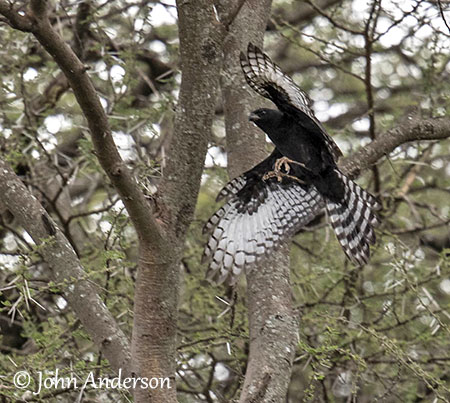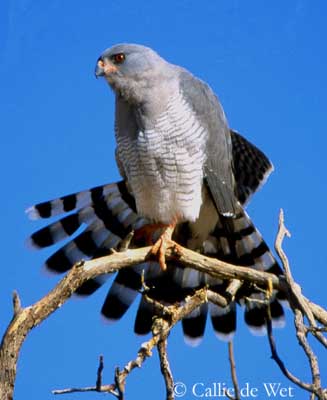
Gabar Goshawk
Melierax gabar
Accipitriforme Order – Accipitridae Family
BIOMETRICS:
Length: 28-36 cm
Wingspan: 63 cm
Weight: M: 110-173 g – F: 180-221 g
DESCRIPTION:
Gabar Goshawk is smaller than other Goshawks. We can observe two morphs, one grey and one almost black. This melanistic form represents about 6 to 25 % of population.
In typical grey morph, adult has plain grey upperparts and white rump. Tail is grey, barred with black.
Underparts are plain grey on chest. Belly is white, barred with grey. Vent is white. Flight feathers are sooty-grey with very pale grey bars. Tail is white with broad dark grey bars.
Head is grey. Bill is black, with red cere and gape. Eyes are deep dark red. Long bare legs and stocky toes are bright red.
Fr: Autour gabar
All : Gabarhabicht
Esp : Gavilán Gabar
Ital : Astore gabar
Nd : Gabarhavik
Russe : Малый Певчий Ястреб
Sd : Gabarhök
Photographers:
John Anderson
John Anderson Photo Galleries
Callie de Wet
GALLERY
Steve Garvie
RAINBIRDER Photo galleries
Simon Tan
PBase Bird galleries
Ingo Waschkies
My bird pictures on Pbase
Text by Nicole Bouglouan
Sources:
HANDBOOK OF THE BIRDS OF THE WORLD Vol 2 by Josep del Hoyo-Andrew Elliot-Jordi Sargatal - Lynx Edicions - ISBN: 8487334156
BIRDS OF AFRICA SOUTH OF THE SAHARA by Ian Sinclair and Peter Ryan - Princeton University Press Princeton and Oxford - ISBN: 0691118159
BIRDS OF PREY OF AFRICA AND ITS ISLANDS by Alan and Meg Kemp - Struik Publishers - ISBN: 1770073698

Melanistic form shows black plumage overall, with pale grey bars across flight feathers above, and white barring below. Red legs scales are flecked with black.
Both sexes are similar, but female is about 15% larger than male.
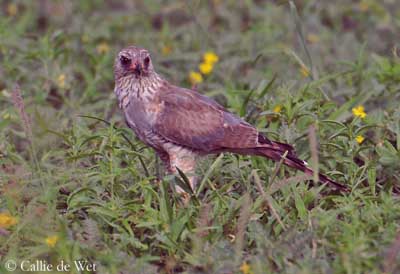
VOICE: SOUNDS BY XENO-CANTO
Gabar Goshawk utters varied piping “kew-ke, kew-ke” during courtship displays. But we can also hear a high-pitched “twee-twit- twee-twee-twee-twit”, uttered when disturbed and alarmed.
HABITAT:
Gabar Goshawk lives in savannahs and semi-arid scrub with scattered trees. It avoids too dense forests and driest deserts. It is rather found in drier thorn savannah, and also along watercourses.
RANGE:
Gabar Goshawk is found in savannahs and steppes of sub-Saharan Africa, extending to Arabian Peninsula.
BEHAVIOUR:
Gabar Goshawk uses several hunting techniques, according to the prey and the place. It is an active and tame hunter.
It strikes from cover, but it also searches for prey while flying very fast; it follows prey into bushes, and tears away and robs nests.
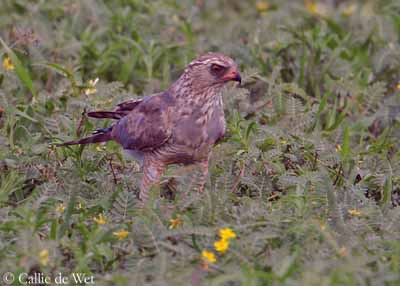
They also hunt in pairs, perched on the sides of bushes and trees, waiting for emerging prey. Sometimes, they can climb through branches.
When breeding season starts, males perch high in trees and gives their whistling calls. Mates often perform flight displays, chasing each other into the trees.
Gabar Goshawk is usually found singly or in pairs.
FLIGHT:
Gabar Goshawk flies fast and low, flapping and then gliding with broad pointed wings. It glides and soars with upcurved wings.
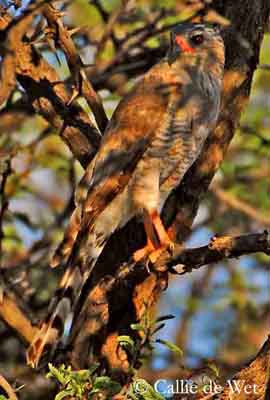
DIET:
Gabar Goshawk feeds mainly on birds (as thrushes), but also on small mammals and lizards. It catches insects on the wing.
PROTECTION/THREATS/STATUS:
Gabar Goshawk is locally common to scarce resident. It is more local in woodlands and around forests patches, avoiding exotic tree plantations.
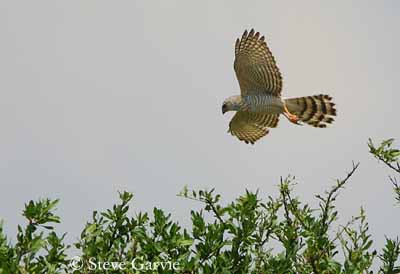
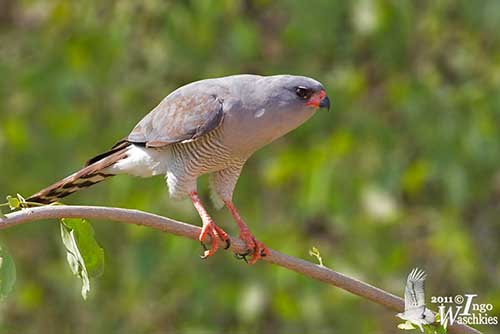
Juvenile has various brown plumages, from pale rufous to dark fuscous.
Upperparts are rather brown with pale streaked head, and pale edges on body feathers.
Underparts are white, broadly streaked brown on chest, and barred brown on belly.
Cere and legs are rather orange-red than in adults. Eyes are pale yellow.
Juvenile melanistic form is dark from hatching.
